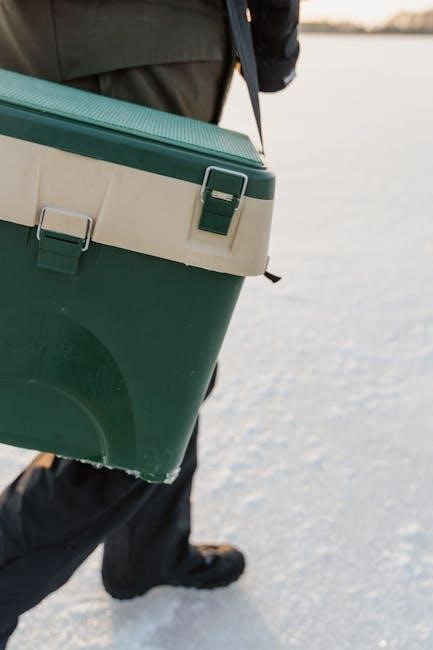
Lake Winnipeg offers world-class ice fishing experiences, especially for trophy greenback walleye. Guided tours provide expert knowledge, ensuring safety and success on its vast, icy waters.
1.1 Overview of Lake Winnipeg as a Premier Ice Fishing Destination
Lake Winnipeg is renowned as a premier ice fishing destination, offering trophy greenback walleye and other species. Its vast, icy expanse attracts anglers worldwide. The lake’s unique structure, with rock piles and deep waters, creates prime fishing spots. Experienced guides and well-equipped tours ensure a safe and productive experience, making it a must-visit for both beginners and seasoned ice fishing enthusiasts.
1.2 Importance of Hiring a Guide for Ice Fishing on Lake Winnipeg
Hiring a guide is crucial for a successful and safe ice fishing experience on Lake Winnipeg. Guides offer local expertise, navigating tricky ice ridges and pressure cracks. They provide access to prime fishing spots, specialized gear, and proven techniques. Their knowledge of fish behavior and lake conditions ensures a higher catch rate, making the investment worthwhile for both novice and experienced anglers.
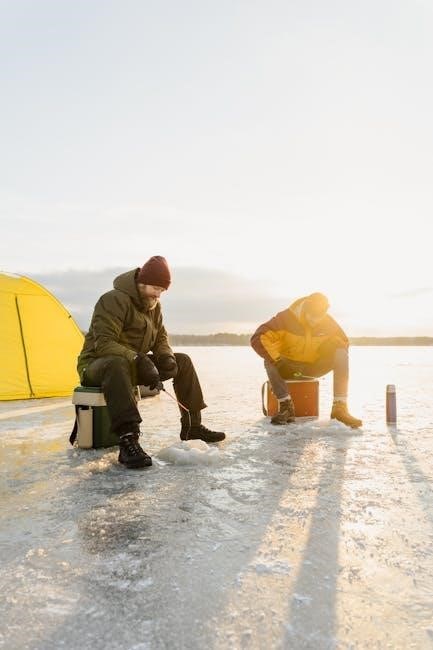
Understanding the Fish Species in Lake Winnipeg
Lake Winnipeg is renowned for its diverse fish species, with trophy greenback walleye being the primary target. Anglers also pursue pike, perch, and other game fish.
2.1 Trophy Greenback Walleye: The Star of Lake Winnipeg Ice Fishing
Lake Winnipeg’s trophy greenback walleye are a prized catch, known for their size and fight. These walleye thrive in the lake’s deep, cold waters, making ice fishing a prime time to target them. Guides often use specialized techniques and locations to maximize chances of landing these elusive, highly sought-after fish during the winter season.
2.2 Other Target Species: Pike, Perch, and More
Beyond walleye, Lake Winnipeg’s icy waters teem with northern pike, yellow perch, and other species. Pike are aggressive and fun to catch, while perch offer fast action and tasty meals. Guides often target these species using varied techniques, ensuring a diverse and exciting ice fishing experience for anglers of all skill levels throughout the winter season.
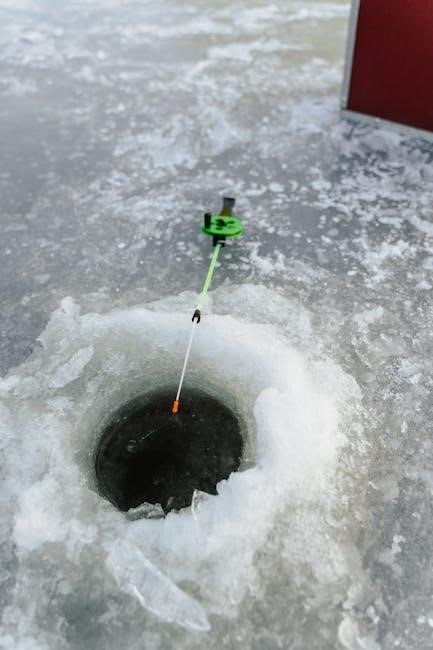
Planning Your Ice Fishing Trip
Plan your Lake Winnipeg ice fishing trip by choosing optimal timing, selecting a reputable guide, and ensuring all permits and gear are ready for a successful adventure.
3.1 Best Time for Ice Fishing on Lake Winnipeg
The best time for ice fishing on Lake Winnipeg is mid-January to late March when ice is safest and walleye are active. Target early morning and late evening for peak bites. Guides recommend planning trips around stable weather patterns to maximize success and safety on the ice.
3.2 Choosing the Right Guide Service
Selecting a reputable guide service is crucial for a successful ice fishing trip. Look for experienced guides with local knowledge of Lake Winnipeg’s hotspots. Ensure they provide necessary gear and emphasize safety. Customizable packages and expert techniques will enhance your experience. A reliable guide ensures you maximize your catch while adhering to regulations and navigating the lake’s unique conditions effectively.
3.3 Essential Permits and Regulations
Before your trip, ensure you have the necessary fishing permits and understand local regulations. Obtain a Manitoba recreational fishing license, available online or at local vendors. Familiarize yourself with daily catch limits, size restrictions, and gear allowances. Adhere to ice fishing-specific rules, such as ice thickness guidelines, to ensure safety and compliance. Check with local authorities for up-to-date information to avoid penalties and help conserve fish populations.
Gear and Equipment for Lake Winnipeg Ice Fishing
Essential gear includes durable rods, high-quality reels, and specialized lures. Don’t forget ice augers, portable shelters, and thermal clothing for extreme cold conditions.
4.1 Ice Fishing Gear: Rods, Reels, and Lures
Light to medium-action ice fishing rods and reels are ideal for Lake Winnipeg. Use jigs, rattle baits, and spoons for walleye and pike. Glow-in-the-dark lures work well in deep waters. Spoons with minnows or plastics attract larger predators. Invest in a GPS unit with a Lake Winnipeg chip to locate rock piles and submerged structures effectively.
4.2 Ice Safety Equipment: Sleds, Augers, and Shelters
Essential gear includes sturdy sleds for transporting equipment, portable ice shelters for wind and cold protection, and reliable augers for drilling holes. Ice picks and a safety rope are critical for emergencies; Always check ice thickness and use GPS for navigation. Proper safety gear ensures a secure and enjoyable ice fishing experience on Lake Winnipeg’s vast, icy landscape.
4.4 Clothing and Accessories for Extreme Cold
Dress in layered, breathable, and moisture-wicking clothing to withstand harsh winter conditions. Insulated, waterproof suits and heavy-duty snow pants are essential. Thermal gloves, hats, scarves, and warm, waterproof boots prevent frostbite. Don’t forget goggles, face masks, and hand/toe warmers for added protection. Proper attire ensures both safety and comfort during long hours on Lake Winnipeg’s icy surface.
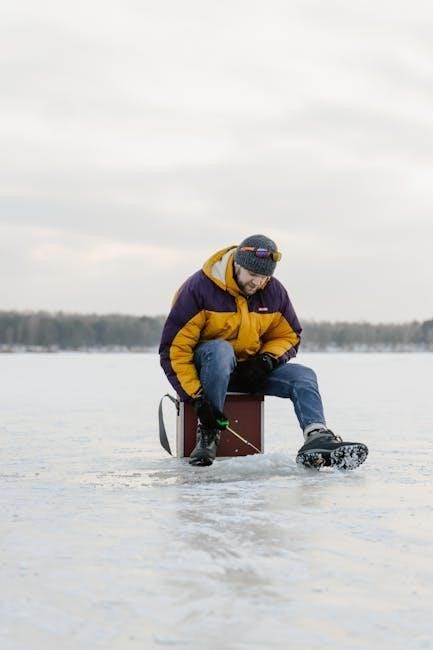
Ice Conditions and Safety
Assessing ice thickness is critical for safe ice fishing. Guides expertly navigate ice ridges and pressure cracks, ensuring a secure experience on Lake Winnipeg’s dynamic ice.
5.1 Assessing Ice Thickness and Safety
Assessing ice thickness is crucial for safety on Lake Winnipeg. Guides use specialized tools to measure ice depth, ensuring it’s safe for equipment and anglers. Clear ice is stronger than white or bubbly ice, with a minimum of 4 inches recommended for walking and 8-12 inches for vehicles. Regular checks and expertise are vital to avoid risks.
5.2 Navigating Ice Ridges and Pressure Cracks
Navigating ice ridges and pressure cracks on Lake Winnipeg requires caution and expertise. Guides use GPS and local knowledge to identify safe routes. Anglers should move slowly, avoid weak spots, and stay alert to shifting ice conditions. Proper equipment, like sleds and augers, aids in crossing challenging areas. Safety is paramount when traversing these natural ice formations.
5.3 Emergency Preparedness on the Ice
Emergency preparedness is crucial for safe ice fishing on Lake Winnipeg. Carry a first-aid kit, ice picks, and a rope. Ensure reliable communication devices are accessible. Stay with a group and inform someone onshore of your plans. Guides often bring rescue equipment and know emergency protocols. Familiarize yourself with ice conditions and have a plan for unexpected situations to ensure a safe experience.
Fishing Techniques for Lake Winnipeg Ice Fishing
Lake Winnipeg ice fishing demands precise techniques like jigging, bait selection, and using electronics to locate and catch walleye, pike, and perch effectively through the ice.
6.1 Jigging Techniques for Walleye and Pike
Jigging is a key technique for targeting walleye and pike on Lake Winnipeg. Use lures like Rattlin’ Rapalas or Jigging Raps to mimic baitfish. Employ a lift-and-drop motion to attract strikes. For walleye, focus on subtle movements, while aggressive jigging works best for pike. Adjust speed based on fish activity and water depth. Proper tackle balance is crucial for detecting bites and landing trophy fish effectively.
6.2 Using Electronics: GPS and Fish Finders
GPS and fish finders are essential tools for Lake Winnipeg ice fishing. Use GPS to locate structures like rock piles and submerged islands. Fish finders provide real-time data on water depth and fish activity, helping you identify schools of baitfish and predators. Combine these tools for precise fishing, ensuring you target the right spots efficiently and maximize your chances of landing trophy walleye and pike.
6.3 Bait Selection and Presentation
Effective bait selection and presentation are crucial for success on Lake Winnipeg. Use jigs tipped with live bait like minnows or maggots to entice walleye and pike. Vibrating lures mimic baitfish, attracting predators. Adjust presentation speed and depth based on fish behavior, ensuring subtle movements to avoid spooking fish in clear icy waters. Proper technique enhances appeal, increasing strike rates for a productive day on the ice.
Choosing the Right Location on Lake Winnipeg
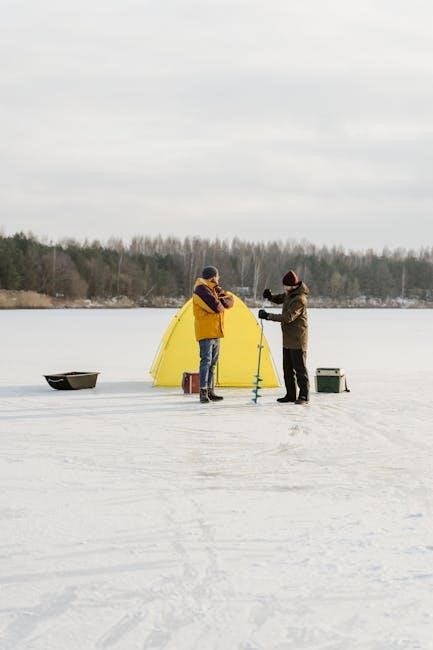
Target rock piles, reefs, and submerged structures for walleye and pike. Guides often use GPS to locate schools and historical hotspots, ensuring optimal fishing spots.
7.1 Popular Ice Fishing Spots and Structures
Key spots include the mouth of the Red River, North Basin, and areas near reefs and rock piles. Submerged islands and drop-offs are prime for walleye and pike. Guides often target structural elements like humps and weed beds, which hold baitfish. These locations provide consistent action and are accessible with proper gear and local knowledge.
7.2 Understanding Depth and Bottom Contours
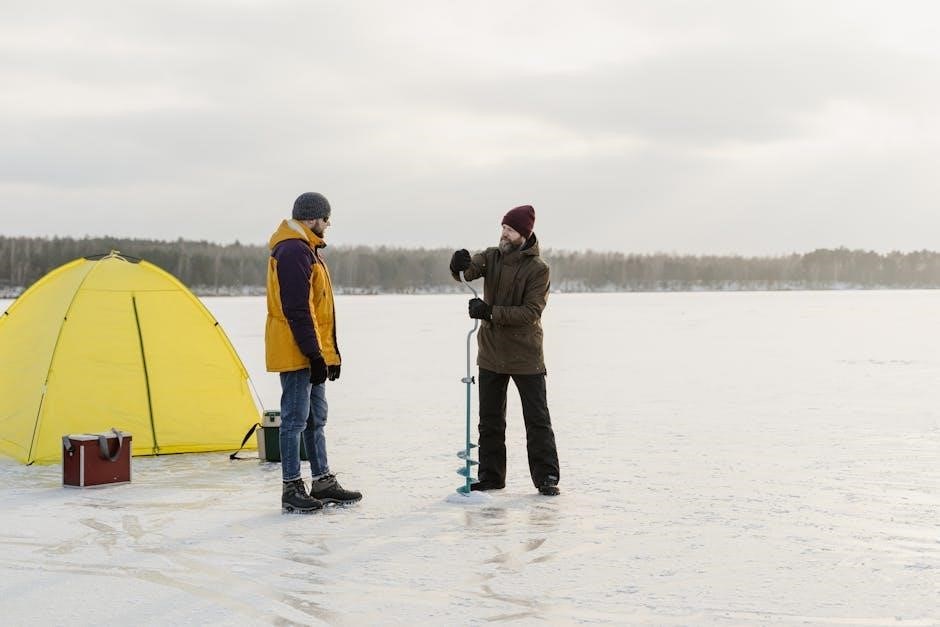
Depth and bottom contours play a crucial role in locating fish. Walleye often gather in deeper areas, while pike frequent shallower zones. Using GPS and fish finders, anglers can map underwater structures like drop-offs, humps, and weed beds. These features trap baitfish, attracting predators. Guides rely on detailed contour maps to identify prime fishing spots, maximizing success on Lake Winnipeg’s diverse ice fishing grounds.
7.3 Adapting to Changing Ice Conditions
Lake Winnipeg’s ice conditions can shift rapidly due to weather. Guides monitor ice thickness, cracks, and slush formation, ensuring safe access. They adjust fishing locations and techniques as conditions change, prioritizing safety and effectiveness. Experience is key to navigating these dynamic environments, making guided tours invaluable for a successful and secure ice fishing experience on the lake.
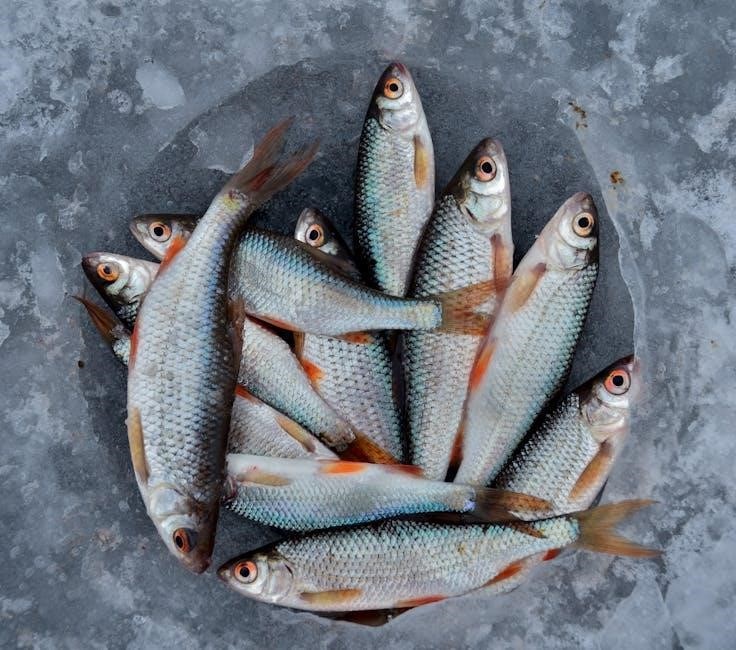
Weather and Ice Fishing Success
Weather significantly impacts ice fishing success on Lake Winnipeg. Wind, temperature, and pressure changes affect fish behavior and ice conditions, requiring adaptability and experience to maximize catches effectively.
8.1 How Weather Patterns Affect Fish Behavior
Weather patterns significantly influence fish behavior on Lake Winnipeg. Cold fronts reduce activity, while warm fronts increase feeding. Wind and temperature changes affect fish movement, pushing them to deeper areas. Changing pressure makes fish cautious, and overcast skies limit their visibility, altering their feeding patterns. Understanding these dynamics is crucial for successful ice fishing.
8.2 Fishing During Different Ice Conditions
Lake Winnipeg’s ice conditions vary, impacting fishing strategies. Solid ice allows for stable setups, while slush or pressure cracks demand caution. Clear ice enhances visibility but can spook fish, while cloudy ice hides movements. Anglers must adapt techniques to ice thickness and texture, ensuring safety and effectiveness. Understanding these conditions is key to a successful and safe fishing experience on the lake.
8.3 Timing Your Trip for Maximum Success
Timing is crucial for a successful ice fishing trip on Lake Winnipeg. Mid-March often offers prime conditions for trophy walleye, as ice remains stable and fish are active. Weather patterns significantly influence fish behavior, with stable conditions typically improving catch rates. Plan your trip during early morning or late evening for peak activity. Adaptability to changing ice and weather conditions is key to maximizing your fishing success.
Handling and Preserving Your Catch
Properly handle fish to avoid damage, store them in insulated containers, and transport safely. Ethical practices ensure sustainability and respect for Lake Winnipeg’s ecosystem and resources.
9.1 Proper Handling to Avoid Damaging Fish
Handle fish gently with wet hands or gloves to prevent removing their protective slime layer. Avoid using nets with holes or rough surfaces. Keep fish moist and cool by storing them in insulated containers with ice. Never over-handle or toss fish, as this can cause internal damage. Clean and prepare fish promptly to maintain quality and freshness for consumption or release.
9.2 Cleaning and Preparing Fish for Consumption
Cleaning and preparing fish from Lake Winnipeg involves scaling, filleting, and removing bloodlines for optimal flavor. Use sharp knives and clean tools to ensure precision. Rinse fish under cold water to remove scales and debris. Pat dry with paper towels before cooking or freezing; Proper preparation preserves freshness and enhances the dining experience, making your catch a culinary delight.
9.3 Transportation and Storage of Your Catch
Properly storing and transporting your catch ensures freshness and quality. Use insulated containers with ice to keep fish cold during transit. Store fish in airtight, labeled containers or vacuum-sealed bags to prevent freezer burn. Keep fish organized by species and date for easy identification. Proper storage maintains the quality of your catch, ensuring a delicious and safe dining experience throughout the year.
Environmental Considerations
Protecting Lake Winnipeg’s ecosystem is crucial for sustainable ice fishing. Ethical practices, such as ‘Leave No Trace,’ ensure minimal environmental impact. Respect for Indigenous lands and waters is essential.
10.1 Leave No Trace: Ethical Ice Fishing Practices
Adopting “Leave No Trace” principles ensures minimal environmental impact. Properly dispose of waste, avoid disturbing natural habitats, and keep the ice clean. Respect wildlife and their habitats by refraining from littering or damaging the surrounding ecosystem; These ethical practices help preserve Lake Winnipeg’s pristine environment for future generations of ice anglers and wildlife alike.
10.2 Protecting Lake Winnipeg’s Ecosystem
Lake Winnipeg’s delicate ecosystem requires careful preservation. Ice fishing practices should avoid harming aquatic life and habitats. Use eco-friendly gear, minimize disturbances, and follow local regulations to protect its biodiversity. By safeguarding the lake’s health, we ensure sustainable fishing opportunities and maintain its natural beauty for future generations to enjoy responsibly.
10.3 Respect for Indigenous Lands and Waters
Lake Winnipeg is deeply connected to the heritage of Indigenous communities. It is vital to respect their traditional lands and water rights. Anglers must adhere to local customs, obtain necessary permissions, and engage respectfully with Indigenous leaders to ensure harmonious coexistence and sustainable use of these sacred resources for future generations.

Guided Ice Fishing Tours and Packages
Lake Winnipeg guided ice fishing tours offer expert-led adventures, ensuring a safe and successful experience. Packages often include gear, permits, and local insights, catering to all skill levels.
11.1 Benefits of Guided Tours for Beginners
Guided ice fishing tours on Lake Winnipeg are ideal for beginners, offering expert instruction and local knowledge. Guides provide essential skills, such as jigging techniques and bait selection, while ensuring safety and maximizing catch potential. Their expertise in navigating ice conditions and locating prime fishing spots enhances the overall experience, making it both educational and enjoyable for new anglers.
11.2 What to Expect from a Professional Guide
A professional guide on Lake Winnipeg offers extensive local knowledge, ensuring prime fishing locations and optimal techniques. They provide high-quality gear, including GPS and fish finders, and emphasize safety with thorough ice assessments. Guides share expert tips on jigging, bait selection, and adapting to changing conditions, enhancing your chances of a successful and memorable ice fishing experience on the lake.
11.3 Customizing Your Ice Fishing Experience
Professional guides on Lake Winnipeg offer tailored packages to suit your preferences, from targeting specific species like walleye or pike to choosing prime locations such as rock piles or deep structures. They adapt to your skill level, whether you’re a novice or experienced angler, ensuring a personalized and memorable adventure on the ice, with expert advice and flexible planning to meet your goals.
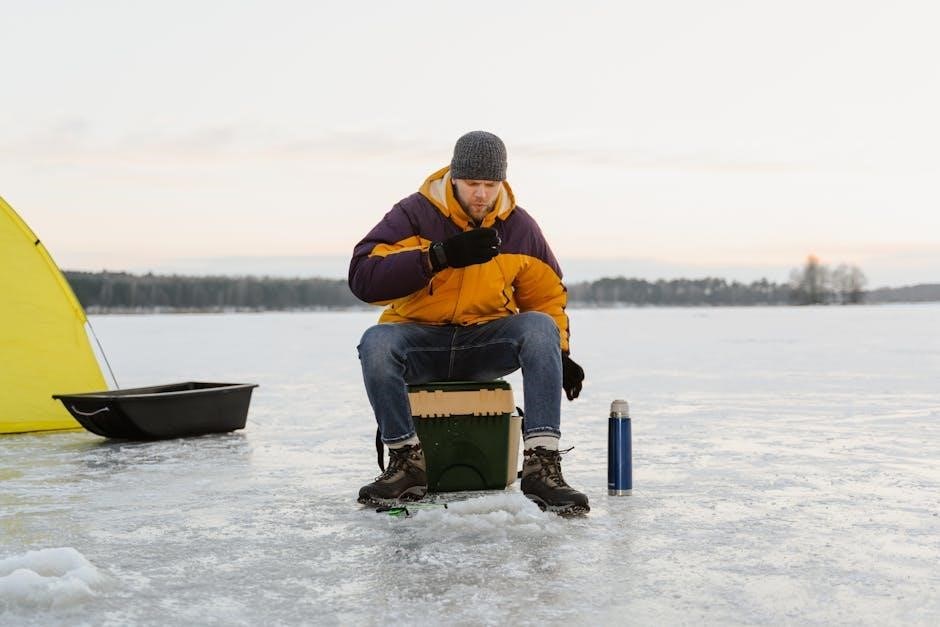
Lake Winnipeg stands out as a must-visit for ice fishing, offering trophy catches and professional guides. Its vast waters provide personalized experiences, making every trip a rewarding adventure.
12.1 Final Tips for a Successful Ice Fishing Trip
Plan thoroughly, hire an experienced guide, and pack essential gear. Respect local regulations and the environment. Stay patient, adapt to changing conditions, and enjoy the serene beauty of Lake Winnipeg’s ice fishing experience for a memorable and successful adventure.
12.2 Why Lake Winnipeg is a Must-Visit Destination
Lake Winnipeg is renowned for its trophy greenback walleye, offering anglers a unique ice fishing experience. With expert guides, pristine ice conditions, and abundant fish populations, it stands as a premier destination for both novice and seasoned anglers seeking adventure and memorable catches in a breathtaking winter landscape.
12.3 Encouragement to Plan Your Next Adventure
Lake Winnipeg’s icy waters promise unforgettable ice fishing adventures. With trophy walleye and expert guides, it’s a must-visit for anglers. Start planning your trip now and experience the thrill of reeling in prized catches in a stunning winter setting. Don’t miss the chance to create lifelong memories on one of Canada’s most iconic fishing destinations.